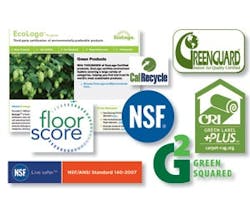Getting To Know Sustainable Flooring
Selecting environmentally preferable, healthier flooring products amidst the vast array of sustainable flooring options on the market today can be a daunting task. From governments and non-governmental organizations (NGOs) to corporations and consumers, purchasers from all walks of life recognize that products with genuinely green attributes are the key to a more sustainable future. And now, these purchasers are demanding proof of those claims.
With the market for sustainable flooring growing at a steady pace, it is important for designers to keep up with the changes. New sustainable product standards are being developed and adopted, innovative product evaluation tools are being introduced, and green codes are being updated. Let’s take a moment to review some of the types and markers of a truly environmentally preferable flooring product.
overview of flooring standards/certifications
ca 01350
This is an emissions test method developed by the State of California which is applicable to all types of flooring. Its full name is “Standard Method for the Testing and Evaluation of Volatile Organic Chemical Emissions from Indoor Sources Using Environmental Chambers Version 1.1 (2010),” and it limits a total of 35 VOCs that are known to off-gas from products. Several product and building certification programs reference this standard as a product emissions baseline.
ecologo® flooring products
standard (ccd-152)
This lifecycle-based, multi-attribute sustainability
standard was developed by EcoLogo to help purchasers
identify holistically greener products. Flooring products from bamboo to resilient flooring to modular carpet have been certified to this standard.
floorscoretm program
This program is run by the Resilient Floorcovering Institute (RFI), and focuses on product emissions. It certifies that products meet the CA 01350 emissions criteria and has no additional requirements.
greenguard children and schools certification programsm
This is a third-party, health-based certification
created and run by the GREENGUARD Environmental Institute to help purchasers identify healthier products. It sets stringent emissions limits on more than 360 chemicals and enforces a limit on total volatile organic compounds (TVOC). More than 1,300 flooring products have been certified to this standard.
green label plus
The Carpet and Rug Institute’s ecolabeling program focuses on product emissions and ensures that certified products meet CA 01350.
green squaredsm certification program
This new multi-attribute sustainability standard was developed by the Tile Council of North America and covers ceramic and glass tile, powder goods, liquid/paste goods, panel goods and sheet goods. The first flooring products are currently undergoing certification, which also involves certification to the ANSI A138.1 standard.
nsf 140 carpet
NSF 140 is a multi-attribute, lifecycle-based sustainability standard. It covers areas such as supply chain feedstock, manufacturing emissions and energy use. Hundreds of carpet products are certified to this standard.
nsf 332 resilient flooring
This relatively new multi-attribute, lifecycle-based sustainability standard was developed exclusively for resilient flooring products. It evaluates resilient flooring against multiple environmental criteria, including design, manufacturing, long-term value, end-of-life management, corporate governance, innovation and performance.
On top of certifications and standards, a new tool available for flooring manufacturers and specifiers is the Environmental Product Declaration (EPD). An EPD is a third-party certified report created by a manufacturer that documents a product’s environmental impacts across its lifecycle. EPDs enable purchasers to compare the environmental attributes of similar products to make more informed purchasing decisions; they also set performance criteria. They are a valuable tool to add to (but not replace) other certifications, and are gaining greater traction as companies see the benefits of sharing additional information for the sake of transparency.
The impact of flooring products on indoor air quality is also a top environmental concern among green building and design professionals. In fact, a steadily increasing number of sustainable building programs, codes, procurement policies, and governmental and corporate specifications incorporate product emissions criteria. Additionally, with the International Green Construction Code (IgCC) officially released in the spring of this year, all flooring with the potential to emit will be required to show compliance with CA 01350.
“The inclusion of emissions criteria in building codes like the IgCC is a testament to the importance of using low-emitting products in the built environment,” says Marilyn Black, Ph.D., founder of the GREENGUARD Environmental Institute. “Flooring is an integral part of the design mix and, therefore, it should adhere to strict indoor contaminant limits to ensure a healthier building.”
what to look for
Designers are frequently faced with the daunting task of distinguishing a truly “sustainable” flooring product from one that is not so green. Associate interior designer Chris Youssef with Perkins + Will, one of the nation’s leading sustainable design firms, admits that the learning curve can be steep, but says that third-party certifications are part of the solution.
“Learning how to identify sustainable flooring products has become easier with tools such as third-party environmental certifications at our disposal,” says Youssef. “The key is for designers to educate themselves on which attributes need to be certified to meet the chosen sustainability goals and priorities, and then finding a credible ecolabel with those products certified under it.”
Proof of sustainability claims and transparency are becoming increasingly important as green building standards become more comprehensive and designers are asked to meet the standards’ requirements. That’s why third-party certifications and EPDs can be extremely valuable. With flooring, every square foot matters, so choose sustainably!
Steve Wenc is president of UL Environment, a business unit of UL (Underwriters Laboratories) that helps companies achieve their sustainability goals and helps consumers find products they can trust. EcoLogo and GREENGUARD are part of UL Environment, which provides environmental claims validation, multi-attribute product certification, environmental product declarations, indoor air quality certification, product emissions testing, organizational sustainability certification and consulting. Learn more at www.ul.com/environment.
